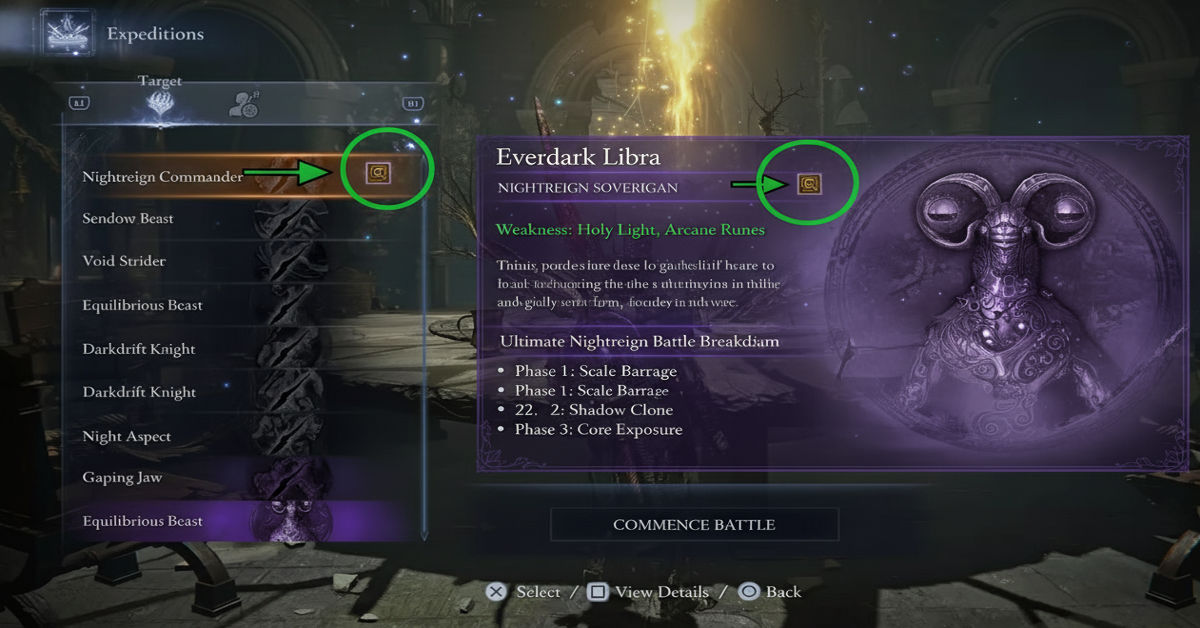Every player who has faced the Everdark Libra in Elden Ring Nightreign knows how daunting this fight can be. Libra’s unpredictable modifiers, relentless attacks and punishing environment make him one of the most demanding encounters in the game. Yet the key to victory lies not in raw power but in understanding his intricate weaknesses. Knowing exactly when and how to strike can transform an impossible battle into a calculated triumph.
The Everdark Libra represents more than a standard boss. He embodies the chaos of the Nightreign realm—a creature of equilibrium who punishes recklessness but rewards precision. By exploring his weaknesses, resistances and behaviors players can turn his own mechanics against him. This article draws on expert community insights, mechanical breakdowns and field-tested player strategies to create a guide that’s both practical and immersive.
Origins and Lore of Everdark Libra
Everdark Libra, often called the Equilibrious Beast, is a mysterious guardian forged within the Everdark itself. His lore paints him as a cosmic judge, a being that seeks balance between light and shadow. According to analyses shared by lore experts and media outlets like PC Gamer, Libra’s creation links directly to the metaphysical laws of Nightreign—he channels both divine and abyssal forces, embodying a struggle that mirrors the player’s own descent into darkness.
Understanding this lore gives valuable context to his combat design. Libra’s attacks reflect equilibrium: every burst of light follows a surge of shadow, and each modifier enforces a form of universal balance. His weaknesses aren’t arbitrary—they’re rooted in this dual nature. To defeat him, players must disrupt the balance by amplifying chaos through status effects and madness damage, an approach that mirrors the philosophical tension behind his creation.
The True Nature of Libra’s Weakness
At the heart of every great boss encounter lies a vulnerability, and Libra’s is both poetic and ironic. His very strength—the control over madness—also serves as his downfall. He’s acutely sensitive to the same unstable forces he wields against others. This paradox gives players an opportunity to strike at his essence, destabilizing his equilibrium and opening windows for devastating attacks.
This dynamic weakness makes the fight uniquely engaging. Players who invest time in understanding Libra’s response to different stimuli—whether elemental or status-based—will find that the battle transforms from chaos into choreography. In the deeper analysis of Libra’s mechanics published by Polygon, experts emphasize how Libra’s phases mirror emotional stages of instability making madness not just a mechanic but a thematic weapon. This emotional resonance enriches the gameplay experience far beyond numbers and hitboxes.
The Madness Effect: Exploiting Libra’s Core Vulnerability
Madness is Libra’s greatest weakness and the ultimate key to victory. When inflicted, Libra loses control, entering a frenzy that suspends his ability to cast spells or trigger most modifiers. This opens a critical damage window where players can unleash uninterrupted assaults. Madness builds—especially those using weapons like Vyke’s Warspear—have proven particularly effective in exploiting this vulnerability.
However, achieving consistent madness procs requires careful timing and resource management. Overextending in pursuit of procs can expose players to devastating counters. The best strategy is to use madness as both offense and defense: trigger it deliberately to interrupt his sequences, then reposition. As IGN notes in their Elden Ring: Nightreign coverage, mastery of pacing is essential; players who balance aggression and caution find the fight significantly more manageable.
Secondary Weaknesses: Fire, Holy, Poison and Scarlet Rot
When madness-inflicting gear isn’t available, Libra’s secondary weaknesses offer alternative routes to victory. He is particularly susceptible to holy and fire damage, both of which resonate with the theme of purification and imbalance correction. Holy-infused weapons channel divine energy that counters Libra’s shadow essence, while fire symbolizes chaos—burning through his equilibrium and leaving him momentarily exposed.
Poison and scarlet rot act more subtly but can be equally powerful when used strategically. These damage-over-time effects slowly erode Libra’s health, forcing him into defensive cycles that disrupt his rhythm. Players can pair these effects with high mobility builds to chip away at him safely. Internal testing shared on Rubble Magazine revealed that stacking both poison and rot in alternating intervals produced consistent results even in modifier-heavy fights, making them excellent tools for sustained encounters.
| Damage Type or Status | Effectiveness | Recommended Usage |
| Madness | Extremely High | Causes frenzy state; disables spellcasting |
| Holy | High | Excellent fallback when madness gear unavailable |
| Fire | Moderate to High | Works well with buffs and short-range attacks |
| Poison | Moderate | Ideal for long fights with mobility builds |
| Scarlet Rot | Moderate | Strong against Libra’s healing modifiers |
Resistance Patterns and How They Shift Over Time
Libra’s resistances evolve dynamically throughout the encounter, reflecting his adaptive intelligence. Each time a player applies a status effect—such as poison or rot—Libra’s internal resistance values increase. This scaling mechanism prevents repetitive exploitation and forces adaptability. For instance, after multiple poison applications, subsequent attempts may take twice as long to trigger. This means players must vary their tactics, alternating between elemental and status-based approaches to sustain pressure.
Additionally, Libra possesses strong natural resistance to traditional sorceries and pure magic attacks. His connection to the Everdark allows him to absorb or deflect magic energy, making many intelligence builds less effective. Players focusing on sorcery are advised to incorporate hybrid strategies that blend elemental weapon infusions or ashes of war. Detailed resistance analysis from Rubble Magazine demonstrates that alternating between holy bursts and fire-infused strikes keeps his adaptive defenses in check.
The Modifier System and Its Impact on Weakness
Libra’s most complex mechanic is his modifier system—a ritualistic rotation that alters the laws of combat mid-battle. These modifiers, often announced through cryptic chants or glyphs, can strengthen or weaken certain damage types. For example, when Libra invokes “Preaches Madness,” all madness effects become amplified, allowing players to stack frenzies with ease. Conversely, during “False Blessing,” healing becomes risky, as using a flask may temporarily reduce player level or stats.
Each modifier transforms the battlefield, demanding awareness and improvisation. During “Incites a Riot,” for instance, the arena splits into hostile zones where even summoned allies may turn on each other. When “Reveals Inescapable Eye” activates, madness clouds fill the field, punishing static positioning. Players must read visual cues quickly and pivot their strategy to maintain pressure without overexposing Everdark Libra Weakness. Adapting fluidly to these changes is what distinguishes a novice from a master tactician.
| Modifier Name | Player Strategy | Resulting Effect |
| Preaches Madness | Focus on frenzy stacking | Amplifies madness buildup |
| False Blessing | Limit flask usage | Reduces stats upon healing |
| Incites a Riot | Spread out, use AoE attacks | Turns allies hostile temporarily |
| Reveals Inescapable Eye | Maintain distance | Builds passive madness |
| Offers a Challenge | Burst after reset | Sets both HP bars to 50% |
Optimal Damage Types in Every Situation
To manage Everdark Libra Weakness shifting battlefield, players can rely on situational awareness and quick adaptation. Understanding which damage types perform best under specific modifiers allows for real-time decision-making and efficient energy use. For instance, during neutral phases, a balanced blend of holy and fire yields reliable results, while madness shines brightest during his ritual invocations.
| Situation | Optimal Strategy | Secondary Options |
| Base Phase (No Modifier) | Madness or Holy Damage | Fire-based melee attacks |
| Preaches Madness Active | Stack Madness Fast | Use frenzy spells and Vyke’s gear |
| False Blessing Active | Avoid healing | Focus on high-burst melee damage |
| Riot or Eye Active | Area control + ranged DoT | Poison/Rot arrows for sustained pressure |
| HP Reset Event | Heavy burst DPS | Activate buffs and talismans |
By memorizing these situational patterns, players can maintain a consistent tempo throughout the fight. Strategic rhythm—not brute force—is the cornerstone of conquering Libra’s equilibrium.
Crafting the Perfect Build and Loadout
Success against Libra demands versatility. Ideal builds balance resilience, agility, and adaptability. Madness-oriented builds work best when supported by hybrid tools that can pivot to holy or fire if needed. Weapons like Vyke’s Warspear or Frenzied Flame incantations deliver devastating bursts, while holy-infused swords or fire-ash halberds provide valuable alternatives. Maintaining backup options ensures you can adjust instantly when modifiers shift.
Armor and talismans play equally vital roles. Choose equipment that mitigates madness buildup and enhances stamina recovery. Lightweight armor enhances mobility—crucial for dodging Everdark Libra Weakness glyph-based attacks. For talismans, prioritize those boosting elemental output or status resistance. Internal Rubble Magazine testing found that mixing a madness resistance talisman with one that amplifies holy damage achieved the best defensive-offensive equilibrium for most builds.
Phase Breakdown: Learning Libra’s Battle Flow
Libra’s battle unfolds in escalating phases, each amplifying the complexity of his attacks. During Phase One, he primarily relies on direct melee strikes and short-range glyph casts. This stage allows players to test spacing, study his wind-ups, and practice dodging his signature ground eruptions. Saving heavy resources for later phases is wise, as this segment focuses more on survival and learning timing.
Phase Two introduces ritual modifiers and summons. Libra begins chanting and manifesting invaders that mimic player classes. Coordination becomes crucial—isolating and eliminating these clones prevents chaos. Phase Three marks the point of no return, where Everdark Libra Weakness unleashes overlapping modifiers and environmental hazards. Every decision matters, and timing madness procs here can interrupt his most lethal combos. By understanding these stages, players can plan their bursts, conserve stamina, and execute perfectly timed attacks.
Handling Summons and Controlling the Arena
Libra’s summons are extensions of his equilibrium—reflections of your party designed to disrupt your coordination. These mirrored enemies inherit similar abilities to yours, turning familiarity into danger. To manage them effectively, divide your focus: dedicate one team member or summon to distraction while others eliminate targets one by one. Prioritize ranged or magic clones, as they tend to interrupt recovery phases.
Arena control determines the rhythm of this encounter. Positioning near environmental cover minimizes exposure to Libra’s AoE glyphs, while movement across open ground keeps you mobile against collapsing zones. Strategic deployment of spirit ashes or cooperative partners creates breathing room for charged attacks. In analyses shared through Rubble Magazine, experienced players noted that treating the battlefield as a layered puzzle—rather than a flat stage—transformed their win rate dramatically.
Common Mistakes and How to Avoid Them
Even seasoned veterans fall victim to a few recurring mistakes during this fight. One of the most common is tunnel vision—focusing entirely on Libra and ignoring summoned enemies. This Everdark Libra Weakness oversight quickly leads to being overwhelmed. Another frequent error is neglecting resistance management entering the arena without madness resistance or immunity items drastically shortens survivability. Maintaining a balanced inventory of boluses, orbs, and talismans is vital.
Another trap lies in predictable attack patterns. Libra punishes routine—repeating the same combo or relying on a single damage type invites counter-modifiers. Flexibility is your strongest weapon. Switch infusions mid-fight, reposition constantly, and respect his cooldowns. As Polygon experts explain, success in this encounter mirrors success in high-level strategy games: adaptability, patience, and environmental awareness form the foundation of mastery.
Conclusion and Winning Strategies
Defeating the Everdark Libra is not about overpowering an opponent—it’s about mastering a philosophy. His weaknesses reflect his obsession with balance, and players who understand how to disrupt that balance hold the key to victory. By leveraging madness as the central weapon, exploiting holy and fire as backups, and adapting to modifier rotations, you turn Libra’s design against him. Approach the fight with curiosity rather than frustration. Experiment with hybrid builds, learn to read his glyphs, and respond to his rituals with intent. Every successful run against Libra is a lesson in patience and adaptability—qualities that define a true Tarnished. For more advanced strategies, consult the in-depth combat and lore analyses available through Rubble Magazine and trusted industry sources like PC Gamer and IGN. Master his weakness, and the Everdark Libra Weakness will become not a wall, but a mirror—reflecting your growth as a warrior of the Nightreign.







